- Joined
- Oct 9, 2007
- Messages
- 47,599 (7.45/day)
- Location
- Dublin, Ireland
| System Name | RBMK-1000 |
|---|---|
| Processor | AMD Ryzen 7 5700G |
| Motherboard | Gigabyte B550 AORUS Elite V2 |
| Cooling | DeepCool Gammax L240 V2 |
| Memory | 2x 16GB DDR4-3200 |
| Video Card(s) | Galax RTX 4070 Ti EX |
| Storage | Samsung 990 1TB |
| Display(s) | BenQ 1440p 60 Hz 27-inch |
| Case | Corsair Carbide 100R |
| Audio Device(s) | ASUS SupremeFX S1220A |
| Power Supply | Cooler Master MWE Gold 650W |
| Mouse | ASUS ROG Strix Impact |
| Keyboard | Gamdias Hermes E2 |
| Software | Windows 11 Pro |
Intel today launches its 11th Gen Core "Tiger Lake" mobile processors that introduce several new technologies on the backs of new IP. As described in the Architecture Day, "Tiger Lake" is built on the 10 nm SuperFin process, and combines new "Willow Cove" CPU cores with the first commercial debut of the Xe Gen12 graphics architecture that Intel is betting big on, to make a stab at the consumer graphics and scalar compute markets. Join us in this live-blog.

Update 16:00 UTC: GB (Gregory Bryant, EVP Client), leads the event from the comfort of his home.

Update 16:04 UTC: Here it is, the "world's best processor for thin and light laptops. You'll notice that like most Intel U-segment chips, this is an MCM of the processor and PCH die. Intel bases its "world's best" claims on a per-segment basis.

Update 16:05 UTC: Acer, Dell, HP, Lenovo, and Samsung have devices with 11th Gen Core processor. Devices as light as 870 g, or lighter than the original Apple iPad. 50+ designs are expected for Holiday 2020, 150 will be available eventually.
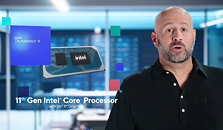
Update 16:07 UTC: Intel's new corporate identity takes flight with the new logos.

Update 16:08 UTC: 10 nm SuperFin: 60 poly pitch transistor, improved gate process, higher mobility, lower drain resistance. We detailed this process node here.
Update 16:08 UTC: Super MIM capacitor is the second key component of 10 nm SuperFin. 20% iso power improvements.

Update 16:10 UTC: 20% CPU IPC uplift, 2x iGPU performance uplift, 5x AI performance uplift, I/O improvements from Thunderbolt 4 and PCIe gen 4. Find out more about the Willow Cove core and CPU performance uplift in our technical article here.

Update 16:11 UTC: LP/DDR5 memory support for future memory. "A processor evolved"
Update 16:12 UTC: Tiger Lake compact logic board for 2-in-1 tablets.

Update 16:13 UTC: AI-accelerated performance much higher than AMD 4800U, as is CPU-heavy workloads. Much of Intel's design focus with this generation has been to leverage new AI-acceleration ISA, and suggest practical client-segment applications of the technology, such as in the area of video conferencing, where AI can be used to clear up your audio or blur/replace your background.

Update 16:15 UTC: Intel claims iGPU gaming performance lead over AMD's 4800U, including FPS. The Iris Xe represents a generational leap in performance for Intel, and we've been tracking performance benchmarks of this solution for several months now, where it's been trading blows with AMD's Vega-based iGPUs.


Update 16:18 UTC: Intel DLBoost will be heavily leveraged for AI-accelerated video-conferencing enhancements and background noise removal.

Update 16:18 UTC: Project Athena I/O. With this generation, USB4, Thunderbolt 4 (80 Gbps), and type-C ports take center-stage. Type-A USB will get increasingly rare. This means a whole ecosystem of new USB connectors, adapters, storage devices, and more, on the anvil.


Update 16:20 UTC: 1-second availability, like an iPad, fast charging, with 40% charge in 30 minutes. A fast-charging standard for laptops was much needed. Modern batteries charge at much higher voltages.

Update 16:22 UTC: New corporate identity.
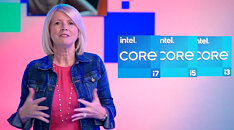
Update 16:29 UTC: Intel EVO powered by Core. It's when 11th Gen Core meets Project Athena. The last time we had such a processor+platform umbrella brand, was with Intel Centrino, from the early 2000s.


Update 16:31 UTC: And that's a wrap for this session. In the next one, we'll cover the underlying architecture.


We will flesh out this whole post with more details over the next half hour, content will update automatically
Update 17:34 UTC: Intel gets into a technical deep-dive of "Tiger Lake"

Update 17:38 UTC: Intel posts some of its first performance guidance for Tiger Lake vs. 4800U.
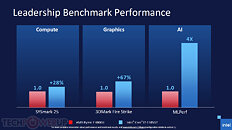


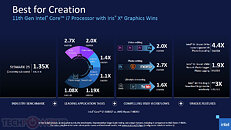
Update 17:41 UTC: Earlier Gregory Bryant, and now Chris Walker, two top Intel execs refer to AMD as "our imitators" rather than "the competition." Clearly Ryzen APUs has Intel rattled, especially with AMD preparing two new APU silicons in 2021.
Update 17:44 UTC: Intel EVO is a combination of Intel Core + Project Athena. Kinda like Intel Centrino, from the 2000s.
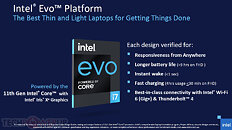
Update 17:46 UTC: Intel highlights its software Software Enabling Engine ecosystem.
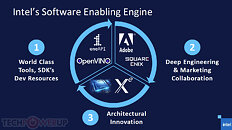
Update 17:48 UTC: Intel is betting bigger on AI, going beyond just DLBoost instruction sets.
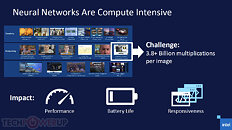


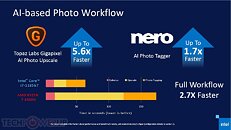
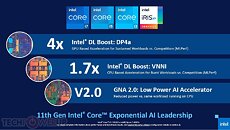
Update 17:51 UTC: Intel develops new DLBoost DP4a evolved instruction set and new GNA accelerator engine.
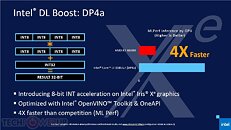


Update 17:56 UTC: An overview of how Tiger Lake is an online collaboration solution powerhouse.

Update 17:58 UTC: Here it is! The first die-shot of TGL 4-core die, complete with its new I/O, interfaces. We get to see how much real-estate is taken up by the CPU cores in comparison to the Gen12 Xe iGPU.
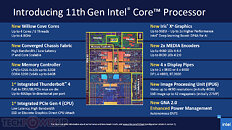
Update 17:59 UTC: And here's the die-shot of the PCH die. On TGL-U, the PCH die sits on the same package, and talks over in-package DMI.

Update 18:00 UTC: Intel details its 10 nm SuperFin foundry node, which was detailed in Intel's Architecture Day brief.
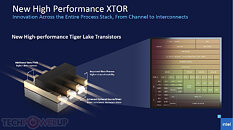


Update 18:02 UTC: "Future Tiger Lake launches" our first hint that Intel isn't stopping with the U-segment.
Update 18:03 UTC: An overview of the "Willow Cove" CPU core, we detailed this in our Architecture Day brief.
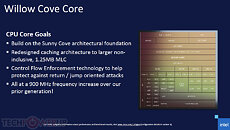
Update 18:05 UTC: Here's the Gen12 Xe iGPU solution, based on Xe LP.

Update 18:06 UTC: This slide details how Intel addressed on-die bandwidth among the CPU- ,iGPU, and memory controllers.
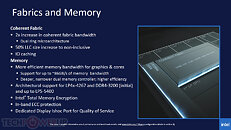
Update 18:07 UTC: Display- and Audio- I/O come together with a focus on enhanced online collaboration enhancements.
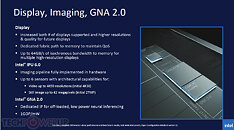
Update 18:08 UTC: USB 4 and Thunderbolt 4 are the two major new I/O features, along with four CPU-attached PCIe Gen 4 lanes for SSDs.
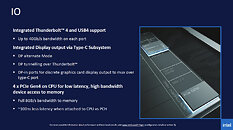
Update 18:09 UTC: A comprehensive power-management solution is at play, which can dynamically wake up resources as they're needed.
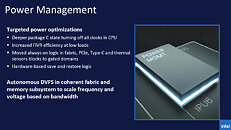
Update 18:11 UTC: An illustration of DVFS. The fabric, memory, and CPU frequency domains are de-coupled.
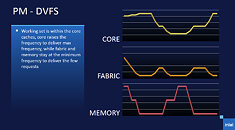
Update 18:13 UTC: Tiger Lake SoC architecture at a glance.

Update 18:15 UTC: Intel elaborates on Intel Xe LP architecture that goes into the Gen12 Xe iGPU of Tiger Lake.Large selection of performance benchmarks.

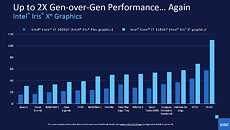
Update 18:17 UTC: Here it is, the Iris Xe Graphics Solution.


Update 18:18 UTC: Xe features Variable Rate Shading Tier-1, which should significantly improve performance.

Update 18:20 UTC: The Xe Software Stack

Update 18:20 UTC: 1080p gaming on an Intel iGPU finally possible.

Update 18:21 UTC: Intel is beating AMD's "Renoir" graphics.

Update 18:22 UTC: ...and NVIDIA's GeForce MX350 discrete graphics solution.

Update 18:23 UTC: Dual Channel memory a "requirement" to ensure sufficient iGPU performance, notebook vendors can't cut corners with single-channel.

Update 18:24 UTC: Gaming + Streaming on iGPU.

Update 18:25 UTC: Ready for next-generation entertainment thanks to hardware decode for the latest video formats.

Update 18:26 UTC: Here it is, the complete product stack of the 11th Gen Core "Tiger Lake" mobile processors. TDP is no longer a flat value.

Update 18:30 UTC: Intel's Turbo Technology design overview.
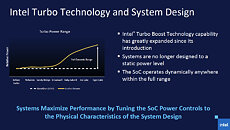
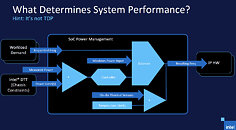
Update 18:33 UTC: TDP across the form-factors.
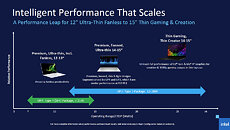
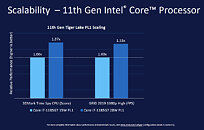
Update 18:34 UTC: Consistency in performance between "AC and DC" (when plugged in vs. on battery)

Update 18:35 UTC: Benchmarks - Productivity, and AI performance.
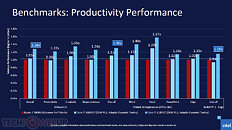
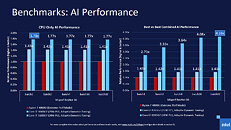
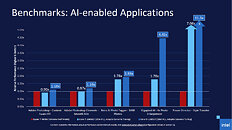
Update 18:39 UTC: Intel talks about real-world benchmarks.

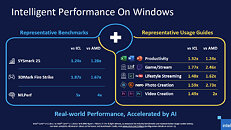
Update 18:43 UTC: A summary of 11th Gen Core "Tiger Lake"

Update 18:45 UTC: Intel DG1 discrete graphics announced!
Tech Q&A Session:

20:05 UTC: Project Athena session is starting now


20:06 UTC: Project Athena focuses on understanding and solving the requirements of the general consumer.

20:07 UTC: All Project Athena laptops come with guarantees, like battery life, responsiveness, etc
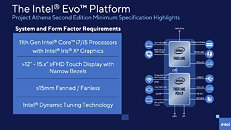
20:09 UTC: Tiger Lake is the foundation for the Intel Evo platform.
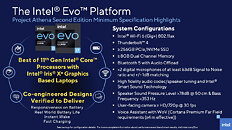
20:11 UTC: The minimum requirements go well beyond just performance. For example, minimum speaker quality is part of the program, too.

20:14 UTC: Size comparison of Tiger Lake UP4 vs other popular platforms.



20:14 UTC: Just like with AMD/NVIDIA graphics cards, Intel is building a reference design laptop, for which they validate all components. Partners get full access to that design and are free to adapt and improve—and feedback back to Intel.


20:19 UTC: Intel is now talking about the research behind project Athena. They worked with various groups, to get a wide sampling of the product's target audience.


20:25 UTC: Times have changed a lot, especially due to COVID.
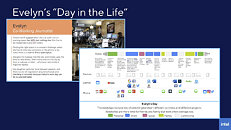

20:29 UTC: Intel created various personas that they used as example for specific workload types.


20:31 UTC: They identified four core computing modes that are relevant for Project Athena laptops.

20:34 UTC: Are we ever going back to work in office spaces? What will we need from future laptops?




20:37 UTC: Intel is now presenting their testing methodology to get performance measurements. The traditional benchmarking is way too engineering specific, designed to isolate selected components performance. The new philosophy is to look for users experiences that get delivered, looking at what people do with their laptops. Testing is done with Internet connected, OEM junkware installed, display brightness at normal levels and on battery.

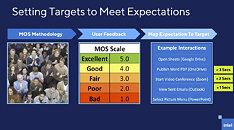
20:46 UTC: One key takeaway is that the feeling of "waiting", which interrupts your workflow, is the driving factor for "perceived" performance. Intel wants to optimize that, even on battery, to deliver a good, responsive, experience.

20:52 UTC: The battery life testing is much more realistic—Intel claims better than anything that exists or has existed in the industry.
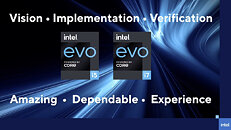
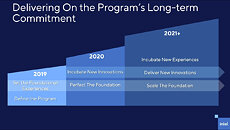
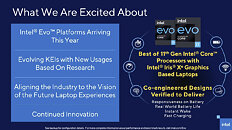

That's the end of the presentation, a Q&A session follows.
View at TechPowerUp Main Site

Update 16:00 UTC: GB (Gregory Bryant, EVP Client), leads the event from the comfort of his home.

Update 16:04 UTC: Here it is, the "world's best processor for thin and light laptops. You'll notice that like most Intel U-segment chips, this is an MCM of the processor and PCH die. Intel bases its "world's best" claims on a per-segment basis.

Update 16:05 UTC: Acer, Dell, HP, Lenovo, and Samsung have devices with 11th Gen Core processor. Devices as light as 870 g, or lighter than the original Apple iPad. 50+ designs are expected for Holiday 2020, 150 will be available eventually.

Update 16:07 UTC: Intel's new corporate identity takes flight with the new logos.

Update 16:08 UTC: 10 nm SuperFin: 60 poly pitch transistor, improved gate process, higher mobility, lower drain resistance. We detailed this process node here.
Update 16:08 UTC: Super MIM capacitor is the second key component of 10 nm SuperFin. 20% iso power improvements.

Update 16:10 UTC: 20% CPU IPC uplift, 2x iGPU performance uplift, 5x AI performance uplift, I/O improvements from Thunderbolt 4 and PCIe gen 4. Find out more about the Willow Cove core and CPU performance uplift in our technical article here.

Update 16:11 UTC: LP/DDR5 memory support for future memory. "A processor evolved"
Update 16:12 UTC: Tiger Lake compact logic board for 2-in-1 tablets.

Update 16:13 UTC: AI-accelerated performance much higher than AMD 4800U, as is CPU-heavy workloads. Much of Intel's design focus with this generation has been to leverage new AI-acceleration ISA, and suggest practical client-segment applications of the technology, such as in the area of video conferencing, where AI can be used to clear up your audio or blur/replace your background.

Update 16:15 UTC: Intel claims iGPU gaming performance lead over AMD's 4800U, including FPS. The Iris Xe represents a generational leap in performance for Intel, and we've been tracking performance benchmarks of this solution for several months now, where it's been trading blows with AMD's Vega-based iGPUs.


Update 16:18 UTC: Intel DLBoost will be heavily leveraged for AI-accelerated video-conferencing enhancements and background noise removal.

Update 16:18 UTC: Project Athena I/O. With this generation, USB4, Thunderbolt 4 (80 Gbps), and type-C ports take center-stage. Type-A USB will get increasingly rare. This means a whole ecosystem of new USB connectors, adapters, storage devices, and more, on the anvil.


Update 16:20 UTC: 1-second availability, like an iPad, fast charging, with 40% charge in 30 minutes. A fast-charging standard for laptops was much needed. Modern batteries charge at much higher voltages.

Update 16:22 UTC: New corporate identity.

Update 16:29 UTC: Intel EVO powered by Core. It's when 11th Gen Core meets Project Athena. The last time we had such a processor+platform umbrella brand, was with Intel Centrino, from the early 2000s.


Update 16:31 UTC: And that's a wrap for this session. In the next one, we'll cover the underlying architecture.


We will flesh out this whole post with more details over the next half hour, content will update automatically
Update 17:34 UTC: Intel gets into a technical deep-dive of "Tiger Lake"

Update 17:38 UTC: Intel posts some of its first performance guidance for Tiger Lake vs. 4800U.




Update 17:41 UTC: Earlier Gregory Bryant, and now Chris Walker, two top Intel execs refer to AMD as "our imitators" rather than "the competition." Clearly Ryzen APUs has Intel rattled, especially with AMD preparing two new APU silicons in 2021.
Update 17:44 UTC: Intel EVO is a combination of Intel Core + Project Athena. Kinda like Intel Centrino, from the 2000s.

Update 17:46 UTC: Intel highlights its software Software Enabling Engine ecosystem.

Update 17:48 UTC: Intel is betting bigger on AI, going beyond just DLBoost instruction sets.





Update 17:51 UTC: Intel develops new DLBoost DP4a evolved instruction set and new GNA accelerator engine.



Update 17:56 UTC: An overview of how Tiger Lake is an online collaboration solution powerhouse.

Update 17:58 UTC: Here it is! The first die-shot of TGL 4-core die, complete with its new I/O, interfaces. We get to see how much real-estate is taken up by the CPU cores in comparison to the Gen12 Xe iGPU.

Update 17:59 UTC: And here's the die-shot of the PCH die. On TGL-U, the PCH die sits on the same package, and talks over in-package DMI.

Update 18:00 UTC: Intel details its 10 nm SuperFin foundry node, which was detailed in Intel's Architecture Day brief.



Update 18:02 UTC: "Future Tiger Lake launches" our first hint that Intel isn't stopping with the U-segment.
Update 18:03 UTC: An overview of the "Willow Cove" CPU core, we detailed this in our Architecture Day brief.

Update 18:05 UTC: Here's the Gen12 Xe iGPU solution, based on Xe LP.

Update 18:06 UTC: This slide details how Intel addressed on-die bandwidth among the CPU- ,iGPU, and memory controllers.

Update 18:07 UTC: Display- and Audio- I/O come together with a focus on enhanced online collaboration enhancements.

Update 18:08 UTC: USB 4 and Thunderbolt 4 are the two major new I/O features, along with four CPU-attached PCIe Gen 4 lanes for SSDs.

Update 18:09 UTC: A comprehensive power-management solution is at play, which can dynamically wake up resources as they're needed.

Update 18:11 UTC: An illustration of DVFS. The fabric, memory, and CPU frequency domains are de-coupled.

Update 18:13 UTC: Tiger Lake SoC architecture at a glance.

Update 18:15 UTC: Intel elaborates on Intel Xe LP architecture that goes into the Gen12 Xe iGPU of Tiger Lake.Large selection of performance benchmarks.


Update 18:17 UTC: Here it is, the Iris Xe Graphics Solution.


Update 18:18 UTC: Xe features Variable Rate Shading Tier-1, which should significantly improve performance.

Update 18:20 UTC: The Xe Software Stack

Update 18:20 UTC: 1080p gaming on an Intel iGPU finally possible.

Update 18:21 UTC: Intel is beating AMD's "Renoir" graphics.

Update 18:22 UTC: ...and NVIDIA's GeForce MX350 discrete graphics solution.

Update 18:23 UTC: Dual Channel memory a "requirement" to ensure sufficient iGPU performance, notebook vendors can't cut corners with single-channel.

Update 18:24 UTC: Gaming + Streaming on iGPU.

Update 18:25 UTC: Ready for next-generation entertainment thanks to hardware decode for the latest video formats.

Update 18:26 UTC: Here it is, the complete product stack of the 11th Gen Core "Tiger Lake" mobile processors. TDP is no longer a flat value.

Update 18:30 UTC: Intel's Turbo Technology design overview.


Update 18:33 UTC: TDP across the form-factors.


Update 18:34 UTC: Consistency in performance between "AC and DC" (when plugged in vs. on battery)

Update 18:35 UTC: Benchmarks - Productivity, and AI performance.



Update 18:39 UTC: Intel talks about real-world benchmarks.


Update 18:43 UTC: A summary of 11th Gen Core "Tiger Lake"

Update 18:45 UTC: Intel DG1 discrete graphics announced!
Tech Q&A Session:

- When will these devices be available? 150 platform designs across consumer and commercial. 50 of those will be available this Holiday season, starting October. 20 of those will be the new "EVO" platform.
- Is the "Iris" Xe graphics core the same as the UHD architecture? It's the new Xe core across the whole product line from i3 to i7. For the higher-end Iris Xe brand you must have dual-channel and higher core count.
- What's the change in ring frequency vs ICL? The ring is no longer statically bound to CPU freq via ratio but it senses what freq it needs dynamically. For example with 4.8 GHz CPU core, the ring can run very close to that, and even as low at Willow Cove on idle.
- What is the benefit of OpenVino? OpenVino is toolkit that provides developers with pre-trained AI models, which helps accelerate their development. Means they don't have to design and train an AI. It's open source, Python and C++. The library also supports all major data types, including INT8.
- How soon will 11th gen desktops catch up? Stay tuned for those announcements. Next year we will release TGL [mobile] it into commercial, also Celeron and Pentiums.
- How are the PCIe lanes distributed? There's 4 PCIe Gen 4 lanes. So you would either connect a SSD to the PCH and use discrete graphics, or connect the discrete directly to the CPU and the SSD to the PCH.
- UP3/UP4 separation? It is an operating range between 7 and 20 watts. It's really about the density of the board and the form factor. UP4 goes up to 15 W fan-less, thin and lights, sub-12 mm, sub-13" screen size.
- Die size and transistor count? We're keeping that to ourselves.
- TGL PCH manufacturing? 14 nm
- Will all TGL mobile processors be 10 nm? Yes, 10 nm and Superfin.
- When can we expect vPro SKUs? Next year, also for EVO
- Peak gaming performance available for EVO? Yes, EVO requires Iris Xe, which also means dual-channel memory
- Will those improvements, like transistor, metal stack, etc. be only used for mobile? We will apply them on the whole range.
- Is there a gearing ratio between CPU/GPU/Ringbus? We have several clock and voltage domains. The ring is now able to operate autonomously.
- PCIe Gen 4 available for UP3 and UP4? Yes
- Does the PCH offer PCI-Express 4.0? The chipset offers PCI-Express 3.0
- Will we see discrete graphics paired with Tiger Lake? Yes, but thinner and lighter systems will focus on Iris Xe IGP.
- Bigger L2 and L3 affect latency? Yes, but our cache also runs much faster now. In many scenarios the latency is less, despite the larger cache
20:05 UTC: Project Athena session is starting now


20:06 UTC: Project Athena focuses on understanding and solving the requirements of the general consumer.

20:07 UTC: All Project Athena laptops come with guarantees, like battery life, responsiveness, etc

20:09 UTC: Tiger Lake is the foundation for the Intel Evo platform.

20:11 UTC: The minimum requirements go well beyond just performance. For example, minimum speaker quality is part of the program, too.

20:14 UTC: Size comparison of Tiger Lake UP4 vs other popular platforms.



20:14 UTC: Just like with AMD/NVIDIA graphics cards, Intel is building a reference design laptop, for which they validate all components. Partners get full access to that design and are free to adapt and improve—and feedback back to Intel.


20:19 UTC: Intel is now talking about the research behind project Athena. They worked with various groups, to get a wide sampling of the product's target audience.


20:25 UTC: Times have changed a lot, especially due to COVID.


20:29 UTC: Intel created various personas that they used as example for specific workload types.


20:31 UTC: They identified four core computing modes that are relevant for Project Athena laptops.

20:34 UTC: Are we ever going back to work in office spaces? What will we need from future laptops?




20:37 UTC: Intel is now presenting their testing methodology to get performance measurements. The traditional benchmarking is way too engineering specific, designed to isolate selected components performance. The new philosophy is to look for users experiences that get delivered, looking at what people do with their laptops. Testing is done with Internet connected, OEM junkware installed, display brightness at normal levels and on battery.


20:46 UTC: One key takeaway is that the feeling of "waiting", which interrupts your workflow, is the driving factor for "perceived" performance. Intel wants to optimize that, even on battery, to deliver a good, responsive, experience.

20:52 UTC: The battery life testing is much more realistic—Intel claims better than anything that exists or has existed in the industry.




That's the end of the presentation, a Q&A session follows.
- Is there a minimum display resolution for EVO? Yes, Full HD, 1080p
- Any other criteria like PPI? There's slightly different criteria for each kind of display, like OLED has a higher battery drain, etc. Color depth, contrast ratio are also part of the specifications.
- How does EVO compare to gaming laptops with discrete graphics? These laptops are designed for general use, including some gaming and movies. Pure gaming laptops will offer better performance if you do nothing but game all day. EVO offers unseen performance per Watt though.
- Does EVO apply to non-touch or clamshell designs? Yes, and we still insist on minimum levels of responsiveness and battery life.
- Is the noise cancellation technology specific to the laptop's in-built speakers and microphone? No, it will work with a headset, too, for example.
- Is there a cost for OEMs to have their laptops verified? It's a co-engineering program, which we've been doing for many years with the OEMs. We're providing the specification guidance a long time ahead and they give us feedback. That's how we make the next-generation laptop.
- What does EVO stand for? We tested it on a target audience, it gives a sense of flow and evolution—laptop evolved.
View at TechPowerUp Main Site









